Last Updated on: September 1, 2025Choosing lights for events feels like a gamble. Get it wrong, and you’ve wasted money on fixtures that fail or underperform, ruining the entire atmosphere for everyone.
For outdoor events and temporary sites, the best LED floodlights are durable, portable, and efficient. Prioritize models with a high IP rating (IP65+), die-cast aluminum housing for heat dissipation, and a high luminous efficacy (actual lumens per watt) to ensure bright, reliable illumination.
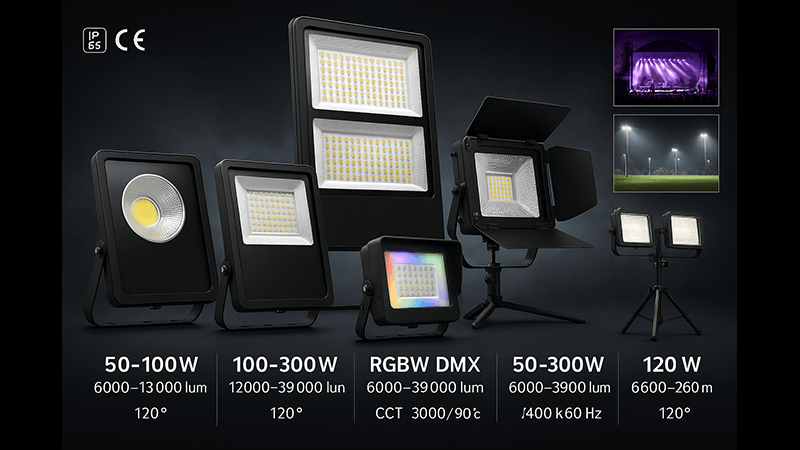
Getting the right light is about more than just picking one from a catalog. I’ve spent my career in the LED lighting industry, and I’ve seen firsthand how misleading specs can be. You need to understand what really matters behind the numbers to make sure you get lighting that works night after night, without fail. It’s about knowing which questions to ask and what details to look for.
Let’s break down the key factors so you can choose your next set of floodlights with confidence.
How many lumens should an outdoor flood light be?
Need bright light but not sure how much? Buying lights that are too dim is useless, but overspending on extreme brightness wastes money. Let’s find the sweet spot.
The right lumen count depends on the area and task. For general ambient lighting at an event, aim for 20-50 lumens per square foot. For a 1,000-square-foot area, this means you need a total of 20,000 to 50,000 lumens from all your fixtures.
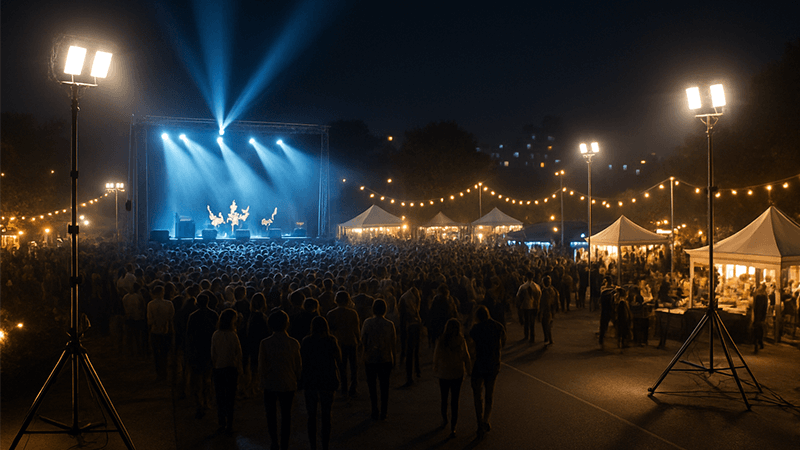
Dive Deeper: The Trap of "Claimed" Lumens
The number you see on the box is often not the light you get. This is one of the most common issues I see, and it’s a huge problem for purchasing managers like my client Shaz. A manufacturer might claim a floodlight produces 10,000 lumens, but when you actually measure it, it’s closer to 7,000. Why does this happen? They often use the "theoretical" or "chip initial value" of the LED chip itself. This number completely ignores the real-world factors that reduce light output. Every component between the chip and the outside world, like the lens and the protective cover, causes some light loss. This is called optical loss, and cheap components can reduce output by 30% or more.
I always advise clients to ask for a photopic test report for the entire fixture, not just the spec sheet for the LED chip. This report, often from an integrating sphere test, shows the true, usable lumens that the floodlight produces.
To help you plan, here’s a simple guide for different event spaces:
| Event Area Type |
Recommended Lumens (per sq. ft.) |
Illumination Goal |
| General Walkways & Perimeters |
10 – 20 lm/sq. ft. |
Safe navigation, basic visibility |
| Food Stalls & Vendor Booths |
30 – 50 lm/sq. ft. |
Good visibility of products and signs |
| Temporary Parking Lots |
5 – 10 lm/sq. ft. |
Safety and security |
| Stage or Performance Area |
70 – 150+ lm/sq. ft. |
High visibility for performers |
Don’t just buy based on the advertised lumens. Ask for proof, and calculate your needs based on the space you’re illuminating. A trustworthy supplier will have no problem providing you with these real-world test reports.
How to choose an outdoor flood light?
Navigating all the technical specs is confusing. Choosing wrong means you’re stuck with unreliable lights that cost you more in the long run through replacements and poor performance.
To choose the right floodlight, look beyond wattage. Focus on the fixture’s true lumen output (efficacy), beam angle, weatherproof rating (IP65 or higher), housing material (die-cast aluminum is best), driver quality, and color consistency (CCT and CRI).
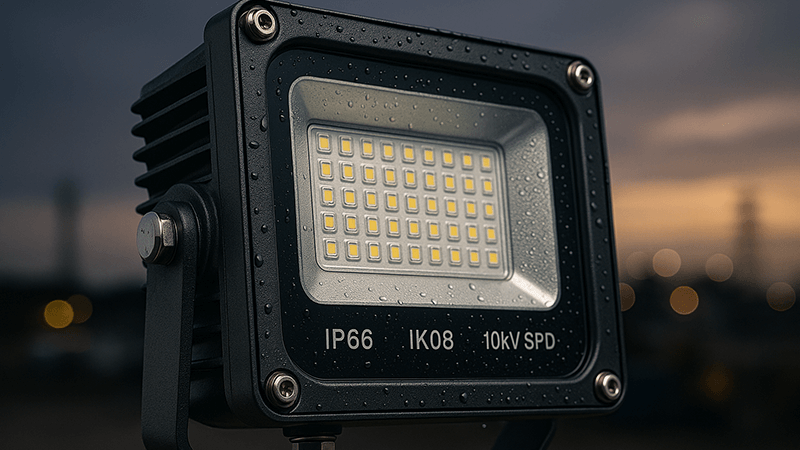
Dive Deeper: It’s More Than Just the LED Chip
Many suppliers try to impress you by saying their lights use chips that have passed an LM-80 test. It sounds good, but it can be very misleading. Let me explain why.
The LM-80 Report Trap
An LM-80 report is a test of the LED chip module itself, measuring how its light output degrades over time under specific, controlled conditions. It tells you nothing about the quality of the finished floodlight. You can put a world-class engine (the LED chip) into a car with a terrible cooling system and cheap tires, and the car will still perform poorly and break down. The same is true for lights. The biggest enemy of an LED chip is heat. If the floodlight has poor thermal management—for instance, if it’s made from thin, stamped aluminum instead of heavy die-cast aluminum with well-designed fins—the heat won’t escape. The chip will overheat, and its lifespan and light output will drop fast, making that LM-80 report completely meaningless.
Getting the Color Right: CCT and CRI
Another hidden problem is the instability of color temperature (CCT) and color rendering index (CRI). A supplier might promise 6000K "cool white" light, but what you get is a mix of slightly blue lights (6500K) and slightly green ones (5500K). When you install them together, your event space looks like a patchwork quilt of different whites. This "color shift" is a sign of poor quality control. For a professional-looking event, you need consistency.
The CRI is just as important. It measures how accurately the light shows colors. A spec sheet might say Ra > 80, which sounds good. However, you need to ask about the R9 value, which measures how well the light renders saturated reds. In many cheap lights, the R9 value is negative, meaning reds look dull and washed out. This is a disaster for food stalls, merchandise booths, or any area where vibrant colors are important. A good light source will not only have a high general CRI but also a positive and high R9 value.
What is the lifespan of LED floodlights?
Are your "long-lasting" LEDs burning out way too soon? It’s incredibly frustrating when lights advertised to last for years fail after one season. Let’s look at what really determines longevity.
A high-quality commercial LED floodlight should have a rated lifespan of 50,000 hours (L70) or more. This is heavily dependent on the quality of its two most critical components: the LED driver and the effectiveness of the fixture’s heat sink.
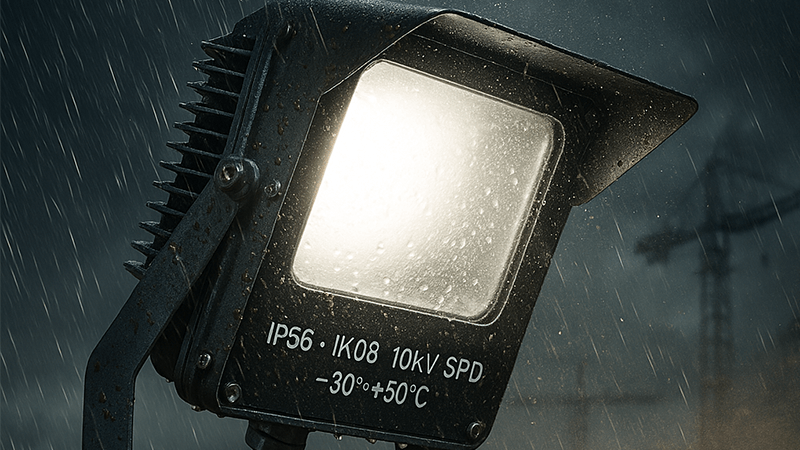
Dive Deeper: Lifespan is Determined by the Weakest Link
When a company advertises a 50,000-hour lifespan, they are usually referring to the L70 rating. This isn’t the point where the light dies completely; it’s the point where its light output has degraded to 70% of its initial brightness. For professional applications, this is considered the end of its useful life. But reaching that 50,000-hour mark is not guaranteed. It depends entirely on the build quality of the fixture.
The Driver is Often the First to Fail
More often than not, the LED driver is the first component to break down, long before the LED chips themselves degrade. The driver is the power supply that converts AC power from the wall into the DC power the LEDs need. It’s a complex piece of electronics that is sensitive to heat and power surges. Low-quality drivers use cheaper components that can’t handle real-world conditions. They overheat and fail, rendering the entire floodlight useless. When I consult with clients, I always tell them to ask about the driver’s brand. Using reliable brands like Mean Well or Sosen is a strong indicator of a quality fixture built to last.
Heat is the Ultimate Killer
As I mentioned before, heat is the number one enemy of LED performance and lifespan. The 50,000-hour rating is based on the LED chip operating at a specific junction temperature (usually around 85°C). A poorly designed housing traps heat, causing this temperature to skyrocket. For every 10°C increase in operating temperature, the lifespan of the electronic components can be cut in half. I remember a project where a client chose our lights, which feature a robust die-cast aluminum body with deep fins, for one section of a large temporary site. For another section, they chose a cheaper competitor’s light with a flimsy housing. After one year of use, our lights were still performing perfectly. Over half of the competitor’s lights had either failed completely or were noticeably dimmer. The difference was simply in the design and the ability to manage heat effectively.
What wattage is best for outdoor flood lights?
Are you still choosing floodlights based on wattage? This is a common but outdated approach that often leads to poor lighting results and wasted energy. Let’s shift the focus.
There is no single "best" wattage. The focus should be on lumen output and efficacy (lumens per watt), not power consumption. A highly efficient 80W floodlight can easily outperform a low-quality, inefficient 100W light, providing more light while using less energy.
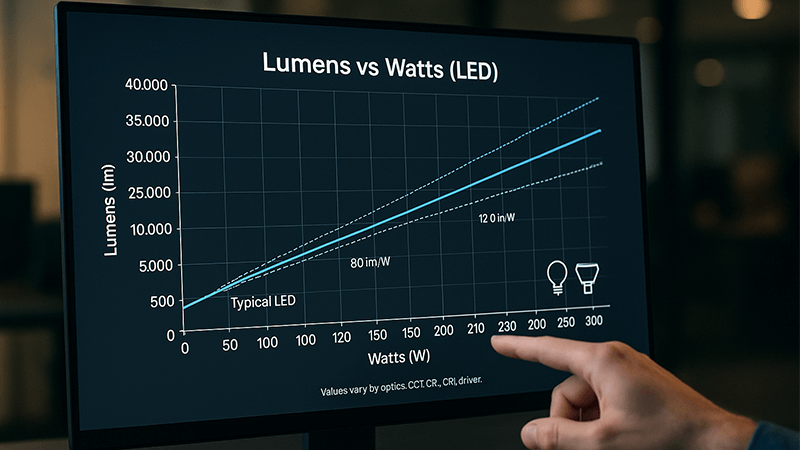
Dive Deeper: Escape the Wattage Trap
For years, we’ve been trained to associate wattage with brightness. With old incandescent bulbs, a 100W bulb was always brighter than a 60W one. In the world of LEDs, that logic no longer applies and can be actively misleading. Two major issues come into play: fake power ratings and the massive variance in efficiency.
The Problem of Fake Power Ratings
This is one of the most direct ways some factories cut costs. They will label and sell a floodlight as a 100W fixture, but when you actually measure its power consumption, it only draws 80W, or sometimes even less. They use a cheaper, lower-power driver and fewer LED chips, but still market it at the higher wattage to compete on price. You think you’re getting a 100W light, but you’re not. This is a simple deception that cheats you out of the performance you paid for. As a buyer, you have the right to ask for a test report showing the actual power draw of the fixture.
Focus on Efficacy (Lumens per Watt)
The most important metric to focus on is luminous efficacy, measured in lumens per watt (lm/W). This tells you how efficiently a floodlight converts electricity into light. This is where quality really shines. Let’s compare two hypothetical floodlights:
| Feature |
Floodlight A (Low Quality) |
Floodlight B (High Quality) |
| Claimed Wattage |
100W |
80W |
| Actual Wattage |
80W |
80W |
| Efficacy |
100 lm/W |
140 lm/W |
| Total True Lumens |
8,000 lm |
11,200 lm |
As you can see, Floodlight B, despite being an "80W" light, produces significantly more light than the "100W" Floodlight A. It’s not only brighter but also more energy-efficient. For temporary sites running on generators or large events with dozens of lights, this energy saving translates directly into lower operating costs. I always tell my team and clients like Shaz to stop asking "what wattage is it?" and start asking "what is its true efficacy in lumens per watt?"
Conclusion
Choosing the right LED floodlight means looking past the marketing claims. Focus on true lumens, quality components like the driver, and smart thermal design for reliable, effective, and long-lasting lighting.